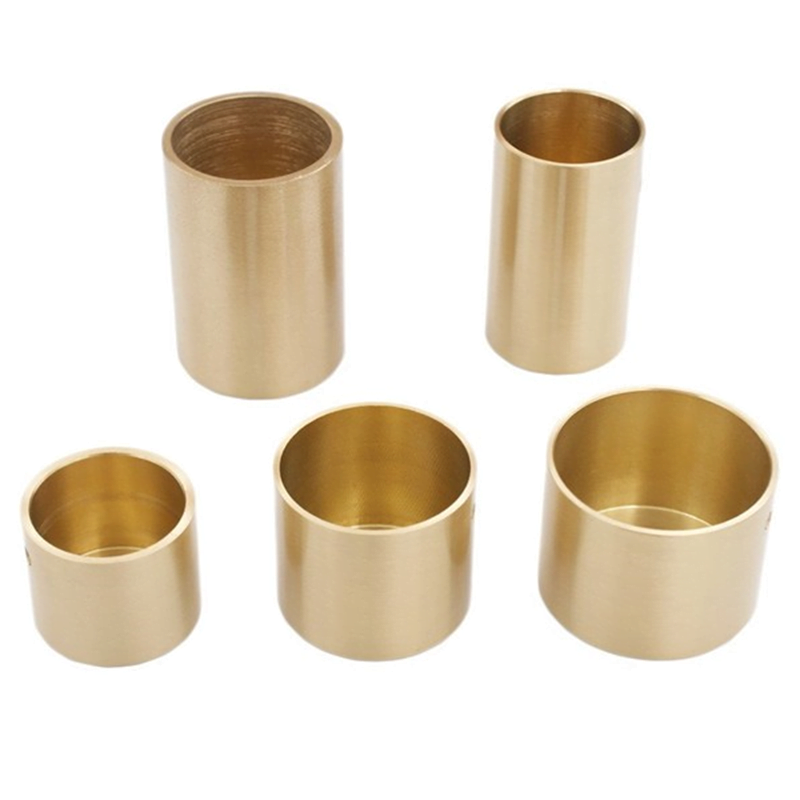บทนำ
ท่ออลูมิเนียมบรอนซ์มีความสำคัญมากขึ้นในการใช้งานเครื่องแลกเปลี่ยนความร้อนทางอุตสาหกรรม เนื่องจากมีการนำความร้อน ทนต่อการกัดกร่อน และความทนทานได้ดีเยี่ยม คู่มือนี้สำรวจกลยุทธ์การปรับให้เหมาะสมเพื่อเพิ่มประสิทธิภาพการถ่ายเทความร้อนและประสิทธิภาพการดำเนินงานสูงสุด
คุณสมบัติและการเลือกใช้วัสดุ
เกรดอลูมิเนียมบรอนซ์มาตรฐานสำหรับท่อแลกเปลี่ยนความร้อน
| ระดับ | องค์ประกอบ | ค่าการนำความร้อน (W/m·K) | แอปพลิเคชันสำคัญ |
|---|
| C61300 | คู-อัล-นี-เฟ | 45-52 | การแปรรูปทางเคมี |
| C61400 | Cu-Al-Ni-Fe-Sn | 42-48 | เครื่องแลกเปลี่ยนความร้อนทางทะเล |
| C63000 | Cu-al-fu | 38-45 | ระบบแรงดันสูง |
| C63200 | คู-อัล-ฟา-ซิก-ซี | 40-46 | สภาพแวดล้อมที่มีฤทธิ์กัดกร่อน |
การวัดประสิทธิภาพเชิงเปรียบเทียบ
| คุณสมบัติ | อลูมิเนียมบรอนซ์ | สแตนเลส | ทองแดง-นิกเกิล |
|---|
| การนำความร้อน | 40-52 วัตต์/เมตร·เค | 16-24 วัตต์/เมตร·เค | 30-45 วัตต์/เมตร·เคลวิน |
| ความต้านทานการกัดกร่อน | ยอดเยี่ยม | ดี | ดีมาก |
| ต้านทานการเปรอะเปื้อน | สูง | ปานกลาง | ปานกลาง |
| ปัจจัยต้นทุน | 1.5-2.0x | 1.0x | 1.3-1.8x |
กลยุทธ์การเพิ่มประสิทธิภาพการออกแบบ
1. การเพิ่มประสิทธิภาพเรขาคณิตของท่อ
| พารามิเตอร์ | ช่วงมาตรฐาน | ช่วงที่ปรับให้เหมาะสม | ผลกระทบด้านประสิทธิภาพ |
|---|
| ความหนาของผนัง | 0.9-1.2มม | 0.7-1.0มม | +5-8% |
| พื้นผิวด้านในเสร็จสิ้น | RA 1.6-3.2 | RA 0.8-1.6 | +3-5% |
| สนามหลอด | 1.25-1.5D | 1.15-1.25ด | +4-7% |
2. การเพิ่มประสิทธิภาพการกำหนดค่าโฟลว์
| การกำหนดค่า | แอปพลิเคชัน | เพิ่มประสิทธิภาพ | แรงดันตก |
|---|
| ทวนกระแส | สูง ∆T | การอ้างอิงฐาน | ปานกลาง |
| ปรับปรุงการไหลสวนทาง | บริการที่สำคัญ | +10-15% | สูง |
| มัลติพาส | พื้นที่จำกัด | +5-8% | สูง |
| ไหลข้าม | ระบายความร้อนด้วยแก๊ส | +3-5% | ต่ำ |
เทคนิคการเพิ่มประสิทธิภาพ
1. วิธีการปรับปรุงพื้นผิว
| วิธี | คำอธิบาย | เพิ่มประสิทธิภาพ | ผลกระทบด้านต้นทุน |
|---|
| การเซาะร่องภายใน | ร่องเกลียว | +15-20% | +30% |
| ครีบภายนอก | ครีบที่เป็นส่วนประกอบ | +25-30% | +40% |
| ปั้นนูน | พื้นผิวพื้นผิว | +10-15% | +20% |
| ไมโครช่อง | ช่องทางภายใน | +20-25% | +45% |
2. การเพิ่มประสิทธิภาพการกระจายการไหล
| เทคนิค | การนำไปปฏิบัติ | ผลประโยชน์ | การพิจารณา |
|---|
| ใบพัดทางเข้า | ผู้อำนวยการไหล | การกระจายอย่างสม่ำเสมอ | ความดันตก |
| ระยะห่างทำให้ยุ่งเหยิง | ช่องว่างที่ปรับให้เหมาะสม | ผสมกันดีกว่า | การซ่อมบำรุง |
| ผ่านการจัด | ผ่านหลายรอบ | ความเร็วที่สูงขึ้น | ความซับซ้อน |
| การออกแบบส่วนหัว | อีควอไลเซอร์ไหล | การไหลสม่ำเสมอ | ค่าใช้จ่าย |
พารามิเตอร์การดำเนินงาน
1. เงื่อนไขการใช้งานที่แนะนำ
| พารามิเตอร์ | ช่วงปกติ | ช่วงสูงสุด | ช่วงที่เหมาะสมที่สุด |
|---|
| ความเร็วของของไหล | 1.0-2.5 ม./วินาที | 0.5-3.0 ม./วินาที | 1.5-2.0 ม./วินาที |
| อุณหภูมิ | 20-150°ซ | -10-200°ซ | 40-120°ซ |
| ความดัน | สูงถึง 20 บาร์ | สูงถึง 40 บาร์ | 10-15 บาร์ |
| ช่วงพีเอช | 6.5-8.5 | 5.0-9.0 | 7.0-8.0 |
2. พารามิเตอร์การตรวจสอบประสิทธิภาพ
| พารามิเตอร์ | วิธีการวัด | ความถี่ | เกณฑ์การดำเนินการ |
|---|
| ค่าสัมประสิทธิ์การถ่ายเทความร้อน | เซ็นเซอร์อุณหภูมิ | รายวัน | <85% design |
| แรงดันตก | เกจวัดแรงดัน | รายชั่วโมง | >120% design |
| อัตราการไหล | เครื่องวัดการไหล | ต่อเนื่อง | <90% design |
| ปัจจัยการเปรอะเปื้อน | คำนวณแล้ว | รายสัปดาห์ | >120% design |
การบำรุงรักษาและการอนุรักษ์ประสิทธิภาพ
1. ตารางการทำความสะอาด
| ประเภทบริการ | วิธีทำความสะอาด | ความถี่ | ผลกระทบด้านประสิทธิภาพ |
|---|
| หน้าที่เบา | การทำความสะอาดสารเคมี | 6 เดือน | +5-10% |
| การปฏิบัติหน้าที่ปานกลาง | การทำความสะอาดเครื่องจักรกล | 3 เดือน | +10-15% |
| หนัก | วิธีการแบบผสมผสาน | รายเดือน | +15-20% |
2. การบำรุงรักษาเชิงป้องกัน
| กิจกรรม | ความถี่ | วัตถุประสงค์ | ผลกระทบต่อประสิทธิภาพ |
|---|
| การตรวจสอบ | รายเดือน | การตรวจพบตั้งแต่เนิ่นๆ | รักษาพื้นฐาน |
| การทดสอบ | รายไตรมาส | การตรวจสอบประสิทธิภาพ | +2-5% |
| การทำความสะอาด | ตามความจำเป็น | การกำจัดคราบสกปรก | +5-15% |
| การเปลี่ยน | 5-10 ปี | ความน่าเชื่อถือ | กลับมาที่การออกแบบ |
กรณีศึกษาการเพิ่มประสิทธิภาพประสิทธิภาพ
กรณีศึกษาที่ 1: โรงงานแปรรูปสารเคมี
- การประยุกต์ใช้: กระบวนการทำความเย็น
- การเพิ่มประสิทธิภาพ: พื้นผิวท่อที่ได้รับการปรับปรุง
- ผลลัพธ์:
- เพิ่มประสิทธิภาพ 25%
- ลดต้นทุนด้านพลังงาน 30%
- ระยะเวลาการทำความสะอาดนานขึ้น 40%
กรณีศึกษาที่ 2: การผลิตไฟฟ้า
- การประยุกต์ใช้: คอนเดนเซอร์ไอน้ำ
- การเพิ่มประสิทธิภาพ: การกระจายการไหล
- ผลลัพธ์:
- การปรับปรุงประสิทธิภาพ 15%
- กำลังการสูบน้ำลดลง 20%
- การบำรุงรักษาลดลง 35%
การวิเคราะห์ต้นทุนและผลประโยชน์
1. ข้อพิจารณาในการลงทุน
| การปรับปรุง | ค่าใช้จ่ายพรีเมี่ยม | ระยะเวลาคืนทุน | ROI |
|---|
| หลอดพื้นฐาน | ฐาน | ฐาน | ฐาน |
| พื้นผิวที่ได้รับการปรับปรุง | +30% | 1.5 ปี | 180% |
| การออกแบบที่ปรับให้เหมาะสม | +20% | 1.2 ปี | 200% |
| โซลูชั่นแบบผสมผสาน | +45% | 2.0 ปี | 160% |
2. การออมในการดำเนินงาน
| หมวดหมู่ | การออมที่เป็นไปได้ | ค่าใช้จ่ายในการดำเนินการ | ผลประโยชน์สุทธิ |
|---|
| พลังงาน | 15-25% | ปานกลาง | สูง |
| การซ่อมบำรุง | 20-30% | ต่ำ | สูงมาก |
| การเปลี่ยน | 30-40% | สูง | ปานกลาง |
สรุปแนวปฏิบัติที่ดีที่สุด
- ขั้นตอนการออกแบบ
- ปรับรูปทรงของท่อให้เหมาะสม
- เลือกเกรดที่เหมาะสม
- พิจารณาคุณสมบัติการปรับปรุง
- แผนการบำรุงรักษา
- การติดตั้ง
- การรองรับท่อที่เหมาะสม
- การจัดแนวการไหลที่ถูกต้อง
- การควบคุมคุณภาพ
- การทดสอบประสิทธิภาพ
- การดำเนินการ
- ตรวจสอบพารามิเตอร์ที่สำคัญ
- รักษาสภาวะที่เหมาะสม
- การตรวจสอบอย่างสม่ำเสมอ
- การบำรุงรักษาเชิงป้องกัน
- การซ่อมบำรุง
- การทำความสะอาดเป็นประจำ
- การตรวจสอบประสิทธิภาพ
- การประเมินสภาพ
- ทดแทนทันเวลา
แนวโน้มในอนาคต
- การพัฒนาวัสดุ
- โลหะผสมขั้นสูง
- การรักษาพื้นผิว
- เคลือบนาโน
- วัสดุอัจฉริยะ
- นวัตกรรมการออกแบบ
- แอพพลิเคชั่นการพิมพ์ 3 มิติ
- การเพิ่มประสิทธิภาพการคำนวณ
- ระบบไฮบริด
- การออกแบบโมดูลาร์
บทสรุป
การปรับปรุงท่ออลูมิเนียมบรอนซ์ในตัวแลกเปลี่ยนความร้อนต้องการ:
- การเลือกวัสดุอย่างระมัดระวัง
- ข้อควรพิจารณาในการออกแบบที่เหมาะสม
- การบำรุงรักษาตามปกติ
- การตรวจสอบประสิทธิภาพ
- การปรับปรุงอย่างต่อเนื่อง
เมื่อนำไปใช้อย่างถูกต้อง กลยุทธ์เหล่านี้สามารถนำไปสู่:
- การปรับปรุงประสิทธิภาพ 15-30%
- ลดต้นทุนการบำรุงรักษา 20-40%
- ประหยัดพลังงาน 25-35%
- อายุการใช้งาน
โดยทั่วไปการลงทุนด้านการปรับให้เหมาะสมจะคุ้มค่าภายใน 1-2 ปี ในขณะเดียวกันก็ให้ประโยชน์ในการดำเนินงานระยะยาวและความน่าเชื่อถือที่ดีขึ้น

